Ancient temples, royal tombs, and breathtaking landscapes—Luxor offers an unforgettable journey through history.
Luxor, often called the world's greatest open-air museum, is a city where ancient history comes to life. Home to the awe-inspiring temples of Karnak and Luxor, the legendary Valley of the Kings, and the magnificent Hatshepsut Temple, Luxor offers visitors a chance to walk in the footsteps of pharaohs. Every structure, every carving, and every monument tells a story of a civilization that shaped the course of history.
Beyond its iconic landmarks, Luxor is a multi-faceted destination. Take a hot air balloon ride at sunrise for breathtaking aerial views of the Nile, explore vibrant local markets, and indulge in traditional Egyptian cuisine. The Luxor Museum and Mummification Museum provide fascinating insights into the art, rituals, and daily life of ancient Egyptians. Whether you're a history enthusiast, an adventurer, or a cultural explorer, Luxor offers an experience like no other.
Ancient temples
Luxor, Egypt, is a treasure trove of ancient history and culture. The city offers mesmerizing sights and activities that transport you back in time. One of the highlights is the collection of ancient temples that showcase Egypt's grandeur and architectural prowess. You'll find awe-inspiring structures that have stood the test of time here.
Karnak Temple
The Karnak Temple is a must-see in Luxor. It's one of the largest temple complexes in the world, dedicated to the god Amun-Ra. The site spans over 200 acres.
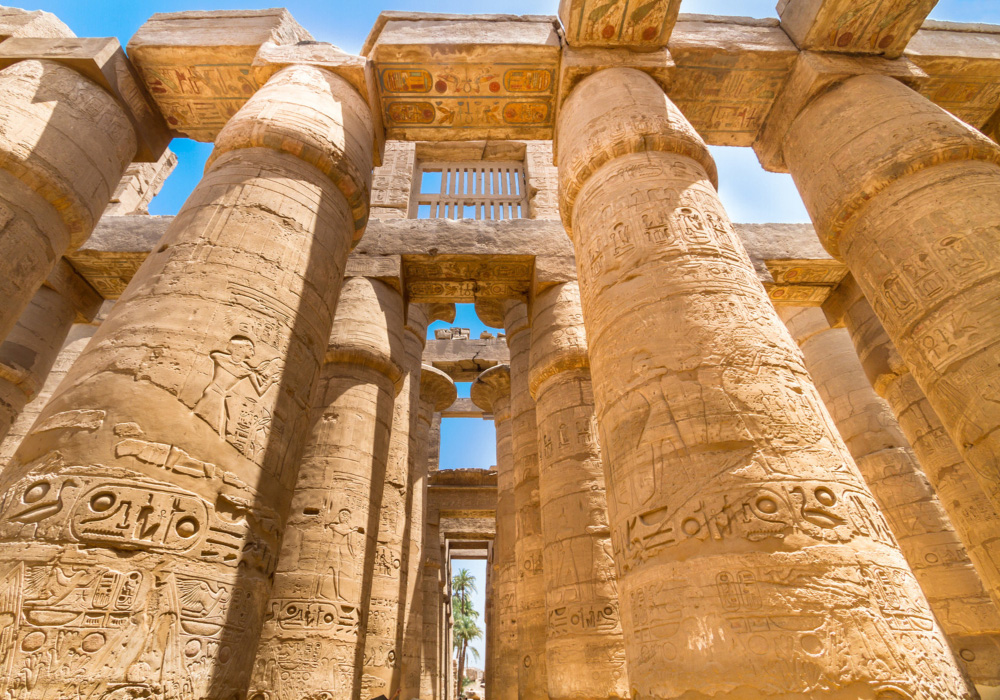
Highlights of Karnak Temple include:
- Great Hypostyle Hall: This hall features 134 massive columns arranged in 16 rows.
- Sacred Lake: Used for ritualistic purposes, it is a peaceful spot within the complex.
- Obelisks: These towering structures are a testament to ancient engineering skills.
Walking through Karnak, you'll notice intricate carvings and hieroglyphics on the walls. The level of detail is astonishing. Every pillar and statue tells a story. Evening sound and light shows bring the temple to life and provide a dramatic retelling of its history.
The Karnak Temple is divided into four main parts:
| Area | Description |
|---|---|
| Precinct of Amun-Ra | The largest section is dedicated to Amun-Ra. |
| Precinct of Mut | Dedicated to the goddess Mut. |
| Precinct of Montu | Dedicated to Montu, the war god. |
| Temple of Amenhotep IV | Later additions by Pharaoh Amenhotep IV. |
Luxor Temple
The Luxor Temple is another significant landmark. It is located in the heart of the city and was built around 1400 BCE. The temple is dedicated to rejuvenating kingship.
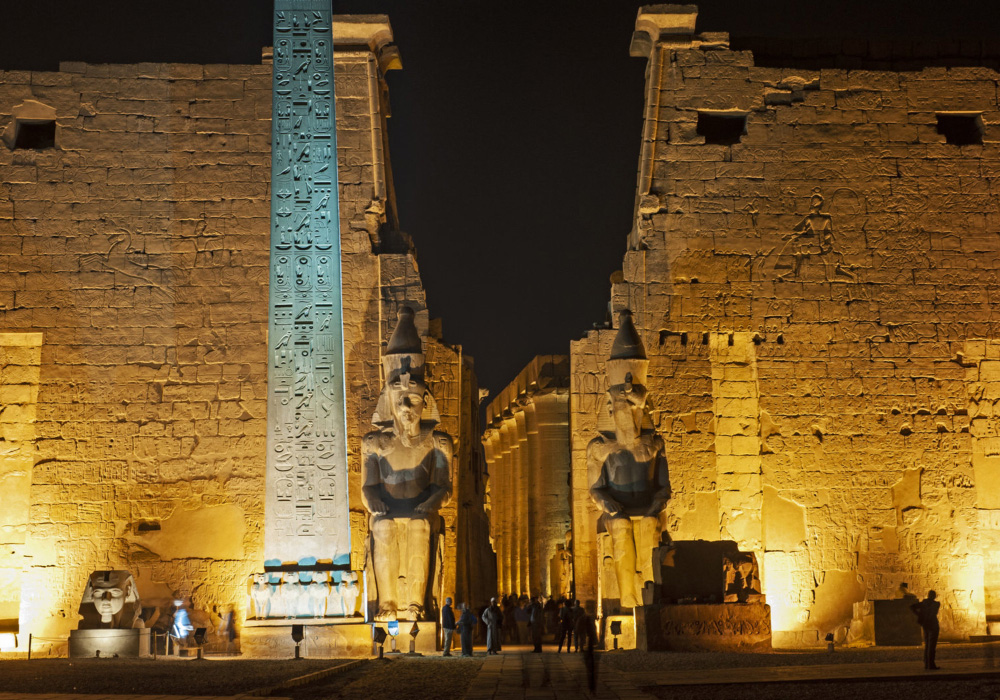
Key features of Luxor Temple include:
- Avenue of Sphinxes: This pathway is lined with sphinx statues and connects Luxor Temple to Karnak Temple.
- First Pylon: The entrance is marked by a massive pylon with impressive carvings.
- Colonnade of Amenhotep III: This section features towering columns and intricate artwork.
Luxor Temple was a ceremonial site. It played a role in the annual Opet Festival, during which statues of deities were paraded from Karnak to Luxor Temple. The temple's architecture combines elements from different periods, including contributions from Pharaohs Amenhotep III and Ramesses II.
The Luxor Temple is divided into the following sections:
| Section | Description |
|---|---|
| Entrance Pylon | Built by Ramesses II, it features reliefs of his military victories. |
| Open Courtyard | Flanked by double rows of columns, it was constructed by Ramesses II. |
| Hypostyle Hall | Contains 32 columns arranged in four rows. |
| Sanctuary | The innermost part is dedicated to the Theban Triad of gods. |
Valley of the Kings
Luxor, Egypt, is a treasure trove of ancient wonders. One of the most remarkable places is the Valley of the Kings. This historic site is a burial ground for pharaohs, known for its stunning tombs and rich history. Every corner of this valley tells a story of ancient Egypt's grandeur and mystery.
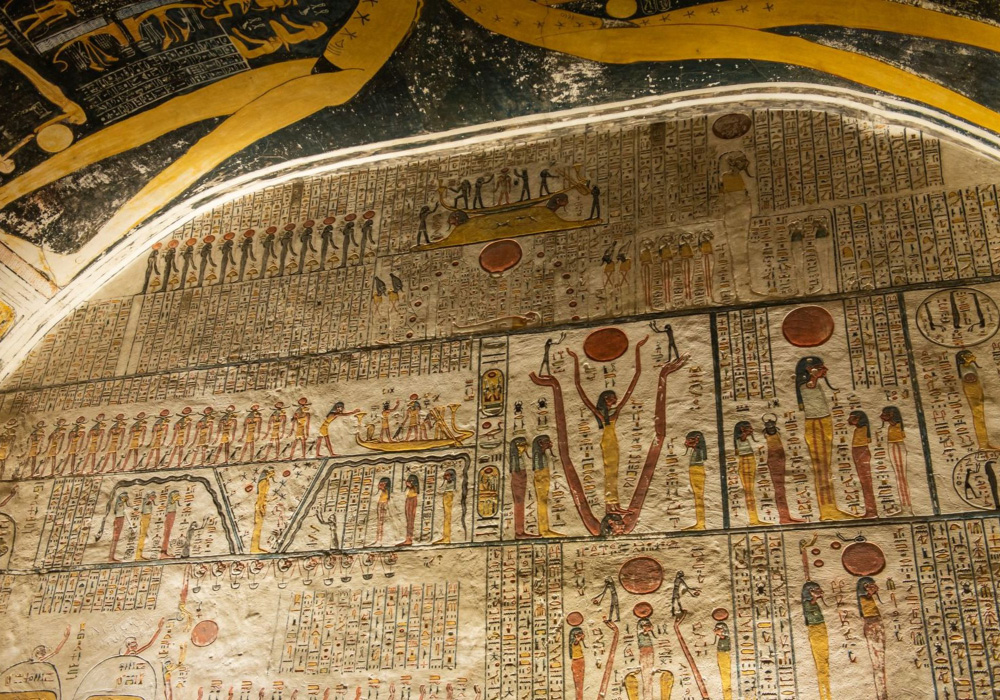
Famous tombs
The Valley of the Kings houses some of the most famous tombs in Egypt. These tombs belong to pharaohs and nobles from the New Kingdom period. Each tomb is a marvel of ancient art and architecture.
Here are some of the most notable tombs you can explore:
- Tomb of Tutankhamun (KV62): Discovered by Howard Carter in 1922, this tomb is famous for its treasures and the young pharaoh's golden mask.
- Tomb of Ramses VI (KV9): Known for its magnificent wall paintings, this tomb is one of the largest and most elaborately decorated.
- Tomb of Seti I (KV17): The longest and deepest tomb in the valley, filled with intricate carvings and vibrant colours.
Visiting tips
Visiting the Valley of the Kings is an unforgettable experience. Here are some tips to make the most of your visit:
- Plan ahead: Purchase tickets in advance to avoid long lines. Some tombs require special tickets.
- Wear comfortable shoes: The terrain is uneven, and you'll be walking a lot.
- Stay hydrated: Bring water, especially during the hot months.
- Hire a guide: A knowledgeable guide can provide insights into the history and significance of each tomb.
- Respect the site: Do not touch the walls or artifacts. Flash photography is usually not allowed.
Here's a list of essential items to bring:
- Water bottle
- Sun hat
- Sunscreen
- Camera (without flash)
- Comfortable clothing
Following these tips ensures a smooth and enjoyable visit, allowing you to fully appreciate the wonders of the Valley of the Kings.
Nile River cruises
One of the best ways to experience Luxor is through Nile River Cruises. These cruises offer breathtaking views, luxury amenities, and a unique perspective on Egypt's ancient wonders. Whether you prefer a serene sunset cruise or an elegant dinner cruise, there's something for everyone.
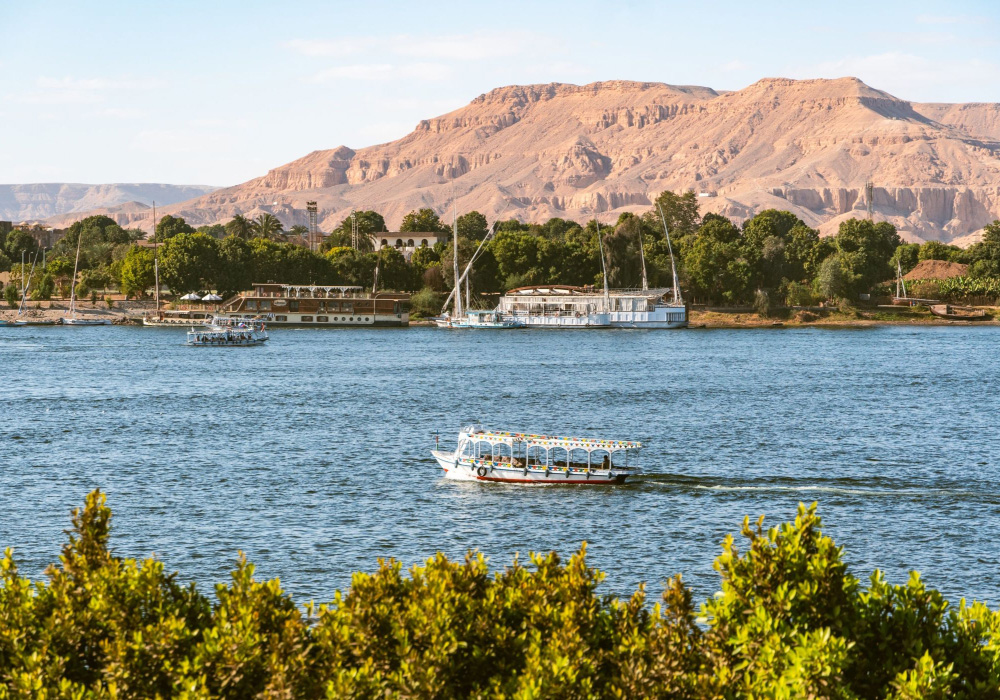
Sunset cruises
Sunset cruises on the Nile River offer a serene and picturesque experience. As the sun sets over Luxor, the sky transforms into a canvas of vibrant colours. These cruises provide an unmatched opportunity to capture stunning photographs and enjoy the tranquil ambiance.
Some highlights of sunset cruises include:
- Stunning views of Luxor's skyline
- Relaxing atmosphere with gentle river breezes
- Complimentary refreshments and snacks
Many cruises also feature live music, adding a magical touch to the evening. You can sit back, sip on a cool drink, and let the melodies enhance your experience.
| Duration | Includes |
|---|---|
| 1-2 hours | Refreshments, Live Music |
Dinner cruises
Dinner cruises on the Nile River offer a luxurious dining experience. Imagine savouring a gourmet meal while floating on the Nile, surrounded by ancient temples and monuments.
Key features of dinner cruises include:
- Delicious multi-course meals
- Elegant ambiance with candlelit tables
- Entertainment such as belly dancing and live music
These cruises typically last around 2-3 hours, providing ample time to enjoy your meal and the stunning views. Many dinner cruises also offer specialty dishes that showcase the flavours of Egyptian cuisine.
| Duration | Includes |
|---|---|
| 2-3 hours | Multi-course Meal, Entertainment |
Whether you are celebrating a special occasion or want to enjoy an unforgettable evening, a dinner cruise on the Nile is a perfect choice.
Local markets
Among Luxor's many attractions, the local markets stand out as a must-visit. Bustling with life, these markets offer a unique glimpse into the daily lives of Luxor's residents. From aromatic spices to handmade crafts, the local markets are a feast for the senses.
Souk experience
The souks in Luxor are a shopper's paradise. Luxor's souks are filled with colourful stalls and lively vendors, each offering a variety of goods. As you stroll through the narrow alleyways, the aroma of spices and incense fills the air.
Popular items to buy include:
- Spices and herbs
- Handmade jewelry
- Traditional clothing
- Local pottery
Engaging with the vendors is part of the fun. They are friendly and often willing to barter, allowing you to practice your bargaining skills. Don't be shy to ask questions about the products and their origins. Many vendors are proud of their goods and enjoy sharing their stories.
To enhance your experience, consider joining a guided tour. Guides can offer insights into the market's history and significance, making your visit more enriching.
Shopping tips
Shopping in Luxor's local markets can be overwhelming, but you'll navigate like a pro with a few tips. First, always carry cash. Many vendors do not accept credit cards, and having small bills will make transactions smoother.
Second, dress modestly. Respecting local customs will make your shopping experience more pleasant. Comfortable shoes are also a must as you'll be doing a lot of walking.
Third, bargaining is expected. Start with a lower price and negotiate your way up. It's part of the culture and can be quite enjoyable.
Here's a quick table of dos and don'ts:
| Dos | Don'ts |
|---|---|
| Carry cash | Accept the first price |
| Dress modestly | Be rude to vendors |
| Practice bargaining | Ignore quality |
Finally, be mindful of your belongings. Keep your valuables secure and stay aware of your surroundings. Following these tips will make your shopping experience in Luxor enjoyable and memorable.
Cultural experiences
The city, known for its ancient temples and vibrant markets, pulsates with a rich cultural heritage. Among the many things to see and do, immersing yourself in the traditional music and dance performances is a must. These experiences provide a unique glimpse into the soul of Luxor, allowing you to connect with its history and people on a deeper level.
Traditional music
Luxor's traditional music is a mesmerizing blend of rhythms and melodies that reflect the city's ancient roots. In many places around the city, you can hear the enchanting sounds of oud, qanun, and tabla. These instruments create a unique soundscape that captures the essence of Egyptian culture.
Here are some places where you can enjoy traditional music in Luxor:
- Karnak Temple Sound and Light Show: Experience a spectacular show with music that tells the story of ancient Egypt.
- Local cafes: Enjoy live performances by local musicians while sipping on traditional Egyptian tea.
- Cultural festivals: Attend festivals where traditional music is a highlight, offering an immersive cultural experience.
Below is a table highlighting some key instruments used in traditional Egyptian music:
| Instrument | Description |
|---|---|
| Oud | A pear-shaped stringed instrument similar to a lute. |
| Qanun | A large, flat instrument with 26 strings, played with plectra. |
| Tabla | A type of drum used in many Middle Eastern musical traditions. |
Dance performances
Dance performances in Luxor are a visual and auditory feast. They capture the spirit of ancient and modern Egypt. Belly dancing is perhaps the most well-known dance form, characterized by intricate movements and vibrant costumes.
Places to watch dance performances include:
- Luxor Cultural Center: Offers regular shows featuring traditional Egyptian dance.
- Nile cruises: Many cruises offer nightly entertainment, including belly dancing performances.
- Local weddings: If you are lucky, you might witness traditional dances at local celebrations.
These performances often feature live music, adding to the immersive experience. Don't miss the chance to see the Tanoura dance, a traditional Egyptian folk dance performed by Sufi men. This dance involves spinning continuously, creating a hypnotic visual display.
Here's a brief overview of popular dance styles in Luxor:
| Dance Style | Description |
|---|---|
| Belly dance | A dance focusing on intricate hip movements and expressive body language. |
| Tanoura | A spiritual dance performed by Sufi men, involving continuous spinning. |
| Folk dance | Traditional dances that depict various aspects of Egyptian life and culture. |
Museums
Luxor, Egypt, is a treasure trove of ancient wonders and historical marvels. Its museums offer a deep dive into the rich heritage of this ancient city. From art collections to the secrets of mummification, Luxor's museums provide a captivating journey through time.
Luxor Museum
Nestled along the Nile, the Luxor Museum houses an impressive collection of artifacts from Thebes. The exhibits are well-curated and provide a window into ancient Egyptian life.
- Statue of Thutmose III: One of the highlights is the statue of Thutmose III, a pharaoh known for his military prowess.
- Royal Mummies: The museum showcases mummies of some of Egypt's most famous pharaohs, including Ahmose I and Ramses I.
- Reconstructed Wall of Akhenaten: This exhibit features a reconstructed wall from the reign of Akhenaten, known for his religious reforms.
The museum is designed to be an educational experience. Each exhibit includes detailed descriptions in Arabic and English, making it easy for visitors to understand the significance of each artifact.
| Exhibit | Description |
|---|---|
| Statue of Thutmose III | A magnificent statue depicting the pharaoh in a powerful stance. |
| Royal Mummies | Mummies of notable pharaohs are preserved with great care. |
| Reconstructed Wall of Akhenaten | A wall showcasing the artistry of Akhenaten's era. |
Visitors can also enjoy the museum's serene garden. It provides a peaceful retreat with views of the Nile. The museum shop offers a variety of souvenirs, from books to replicas of famous artifacts.
Mummification Museum
The Mummification Museum, located on the Corniche, offers a unique insight into the ancient art of preserving the dead. It is dedicated to the rituals and techniques of mummification.
The museum features several fascinating exhibits:
- Mummified Animals: The museum displays mummified animals, including cats and crocodiles.
- Mummification Tools: Visitors can see the tools used by ancient embalmers.
- Detailed Explanations: Information panels explain the process of mummification step-by-step.
A highlight is the mummified remains of Masaharta, a high priest of Amun. The museum also features a reconstructed embalming table. This gives visitors a hands-on understanding of how mummification was performed.
Educational videos play throughout the museum. These videos provide additional context and bring the ancient practice to life. Interactive displays allow visitors to explore the mummification process in detail.
The museum shop offers unique items related to mummification. Visitors can purchase books, replicas, and even papyrus scrolls. The Mummification Museum is a fascinating stop for anyone interested in the ancient Egyptian way of life.
Hot air ballooning
One unforgettable experience is hot air ballooning over the ancient city. Imagine floating over the Nile River, temples, and tombs as the sun rises. This serene adventure provides a unique view of Egypt's rich history.
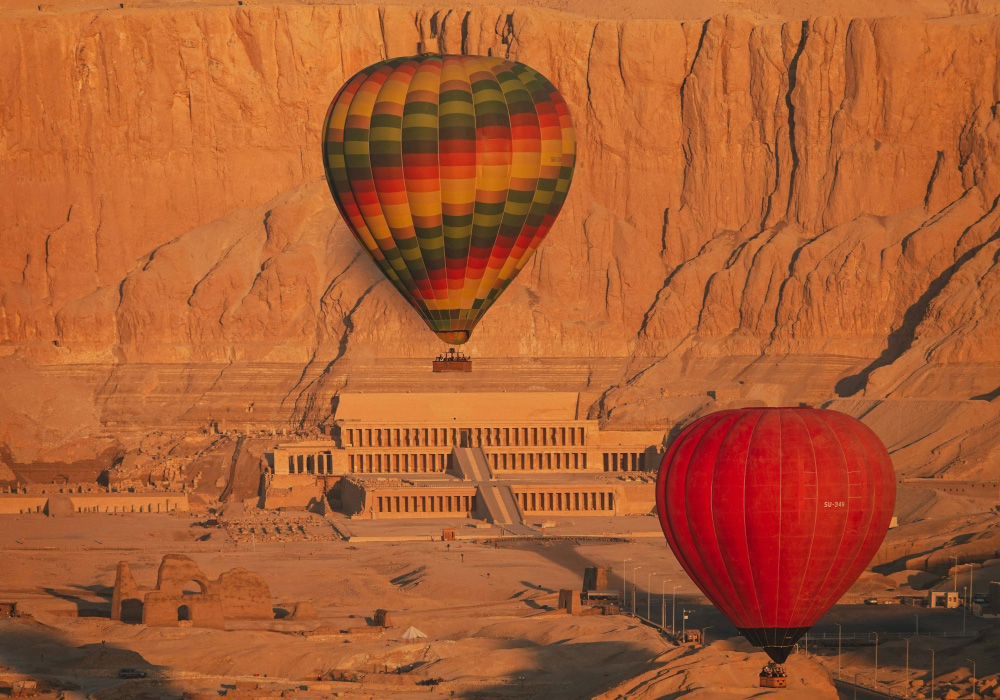
Best times to fly
The best time for hot air ballooning in Luxor is at sunrise. The cool morning air offers optimal flight conditions. The view is breathtaking as the sky changes colours. Here are some reasons why sunrise flights are ideal:
- Cooler Temperatures: Mornings are cooler, making the flight more comfortable.
- Calm Winds: Early hours have calmer winds, ensuring a smooth ride.
- Stunning Views: The sunrise over the Nile and temples is magical.
To make the most of your flight, plan your trip between October and April. These months offer the best weather conditions. Remember to book in advance as these flights are popular.
| Month | Weather Conditions |
|---|---|
| October | Cool mornings, clear skies |
| November | Comfortable temperatures, calm winds |
| December | Chilly mornings, perfect for flying |
| January | Clear skies, cool air |
| February | Calm and clear |
| March | Warming up, still comfortable |
| April | Warm mornings, calm winds |
What to expect
On the day of your flight, expect an early start. Hotel pickups usually happen around 4:30 AM. You'll arrive at the launch site just before dawn. Watching the balloons inflate is part of the experience.
Once in the basket, your pilot will guide you through safety instructions. The ascent is gentle and smooth. As you rise, the view expands, revealing the Nile, temples, and lush fields. Here's what you might see:
- Valley of the Kings: The burial site of famous pharaohs.
- Karnak Temple: An impressive complex with massive columns.
- Hatshepsut's Temple: A stunning mortuary temple.
- Luxor Temple: A beautiful temple in the heart of the city.
- Green Fields: Lush farmlands along the Nile.
The flight lasts about 45 minutes to an hour. As you descend, you'll see the city waking up. The landing is usually gentle, often in a field. After the flight, enjoy a celebratory drink and receive a flight certificate. This adventure will leave you with lasting memories of Luxor.
Dining options
Luxor, Egypt is a city teeming with history, culture, and breathtaking sights. Among the many activities, exploring the dining options should be at the top of your list. Luxor offers a rich culinary experience, from traditional Egyptian dishes to international flavours. Here, we'll explore what to eat and where to dine in Luxor.
Local cuisine
Luxor's local cuisine is a blend of flavours, spices, and textures that reflect its rich cultural heritage. Egyptian food is both delicious and diverse, making it a must-try for any visitor.
Some of the must-try dishes include:
- Ful Medames: A hearty fava bean stew, often served for breakfast.
- Koshari: A popular street food made with rice, lentils, chickpeas, and pasta, topped with tomato sauce and crispy onions.
- Molokhia: A green, leafy vegetable stew, often served with chicken or rabbit.
- Shawarma: Marinated meat cooked on a spit, typically served in a flatbread.
- Baklava: A sweet pastry made of layers of filo dough filled with nuts and honey.
For those interested in experiencing local cuisine, the following table highlights some popular dishes and their main ingredients:
| Dish | Main ingredients |
|---|---|
| Ful Medames | Fava beans, olive oil, lemon juice, garlic |
| Koshari | Rice, lentils, chickpeas, pasta, tomato sauce, onions |
| Molokhia | Molokhia leaves, chicken or rabbit, garlic, coriander |
| Shawarma | Marinated meat (beef, lamb, chicken), flatbread |
| Baklava | Filo dough, nuts, honey |
Popular restaurants
Luxor boasts a variety of dining establishments that cater to all tastes and preferences. Whether you're craving local dishes or international cuisine, you'll find a restaurant to satisfy your appetite.
Here are some top-rated restaurants in Luxor:
- 1886 Restaurant: Located in the Winter Palace Hotel, this restaurant offers a fine dining experience with a blend of French and Egyptian cuisine.
- Sofra Restaurant & Café: Known for its authentic Egyptian dishes, Sofra provides a cozy atmosphere and delicious meals.
- Africa Restaurant: A favourite among tourists, this restaurant serves traditional Nubian dishes and offers stunning views of the Nile.
- El Hussein Restaurant: This family-run eatery is famous for its seafood and Egyptian specialties.
- The Lantern Room: An English-owned restaurant offering a mix of British and Egyptian dishes, known for its friendly service and warm ambiance.
Luxor is a destination like no other, where ancient history, cultural experiences, and breathtaking landscapes merge to create an unforgettable journey. From towering temples and royal tombs to vibrant souks and scenic cruises, every experience is steeped in history and grandeur.
Whether you're exploring Karnak’s colossal columns, soaring above the Nile at sunrise, or savouring local cuisine, Luxor promises a journey of discovery and wonder. Pack your bags and prepare to be transported through time in the land of the pharaohs!

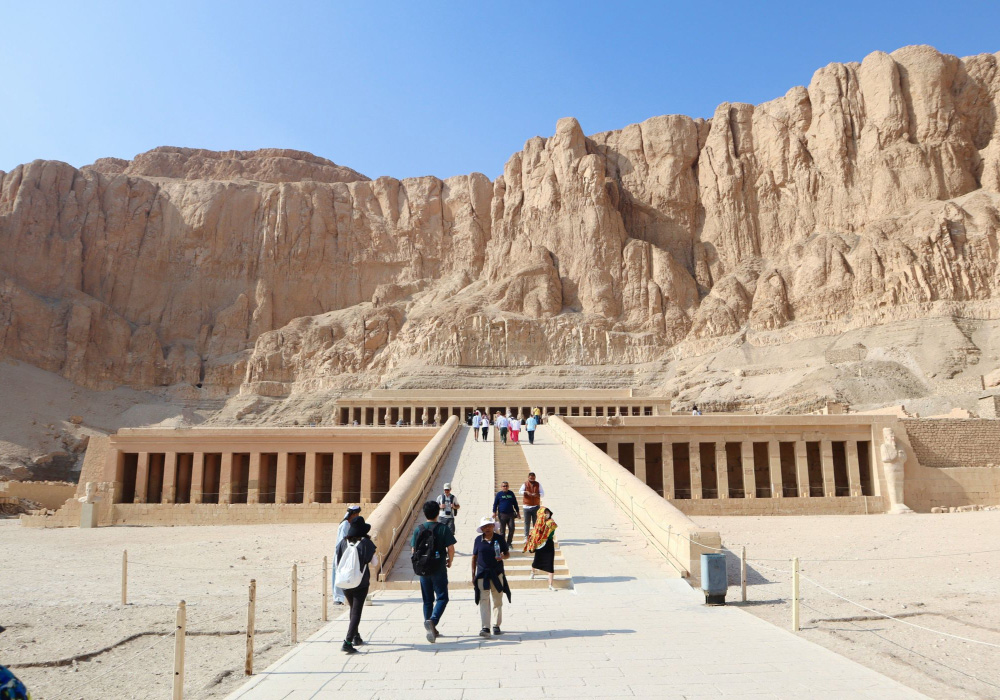


Comments powered by CComment